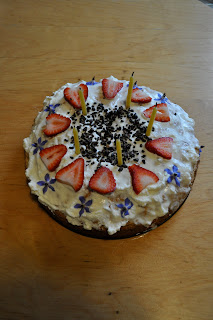The Age of Petrol will not be over for many more years. But it is waning, and the Days of Cheap Oil Energy are probably firmly behind us. I was struck this winter, considering our family's emergency kit, by just how vulnerable we are in regards to fuel. In the city, there is actually lots of food around, especially dried food, and we store quite a bit of water. But we have no wood pile, and certainly no fire pit or wood stove, anyways. I imagine, should an earthquake (this region's flavour of disaster) knock out the power for many days, we would BBQ all our food, probably sharing fuel and grill space with our neighbours. If the power was out for a week or more, we may have to resort to building a fire pit and salvaging wood.
Sadly, it seems one of the victims of the Petroleum Age, is the widespread knowledge of how to cook over a fire. I admit massive ignorance in this department. I've almost exclusively had an electric element to cook with, occasionally using gas flame, but only handful of times have I actually used a wood fire to make my meal. This is very aberrant to history, where knowing how to manipulate a fire to optimally fry, roast and boil was probably mastered by most people before they turned ten.
Here are the few times I have tried, and what I did. Try not to laugh.
Veggie burger and sausages on a grill with corn roasting in the husk just beside the coals. Pretty simple camping food. We used 2 by 4s to hold up the grill, with the intention of tossing them in the fire after.
It all turned out delicious, note the water on the one board, just to keep it from burning faster than we wanted it to.
Another trip, another fire. Here we are again roasting corn in its husk (its great, it gets steamy but loses none of its flavour) and we also have cut up veggies wrapped in foil with garlic butter. This was a grill-less dinner.
This dinner, made on a beach in Haida Gwaii was a little bit more elaborate. We started with mussels we had gathered that afternoon, with a bit of tomato sauce and garlic butter.
Then, while we were snacking on those, we sauteed some meat and started boiling water.
Veggies and mushrooms joined the meat in that pan when the meat was almost done, no extra oil was needed.
And once the pasta was boiled, tomato sauce and buttery greens and a bit of wine were thrown in with the noodles.
Mmmm, I have to say that all these meals are among some of my favourites ever. I think maybe its just the pleasure of eating outdoors, with great scenery and surrounded by nature sounds. Or maybe it is the high heat of the flames and the added flavouring of the smoke? Who knows. I am looking forward to practicing this skill some more.
If you are going to have a fire soon, try these simple ideas. And please, share with me what you and your family cook out in the open.
Banana and Chocolate melt
1 banana per person
half a chocolate bar (go dark if you dare!) per person
foil
Cut the banana in half length wise, sandwich in broken pieces of chocolate, wrap tightly in foil and bake over or beside the coals. When steamy, open and eat the goo with a spoon, or over graham crackers or whatever you got that seems good.
Roasted Yam
One Fat, Round Yam
Yams, or Sweet Potatoes can be roasted right in the coals, if you don't have foil don't worry, only the skin will blacken into charcoal, the insides will be cooked into a soft, moist consistency that you can spoon out onto plates or right into your mouth.
And of course, there are always the marshmallows. Obviously not the healthiest choice, but for one night around the fire with your friends and family, I think you'll be alright.
What kind of things do you cook over a fire?

































